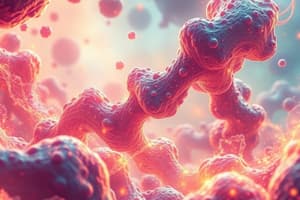Podcast
Questions and Answers
Which of the following describes the function of allosteric enzymes?
Which of the following describes the function of allosteric enzymes?
- They only catalyze reactions in the R state.
- They have a hyperbolic response to substrate concentration.
- They serve as information sensors and catalysts. (correct)
- They are only active at high substrate concentrations.
What characterizes a double displacement enzyme mechanism?
What characterizes a double displacement enzyme mechanism?
- Products are formed simultaneously.
- The enzyme remains unchanged throughout the reaction.
- All substrates must bind before product formation.
- One product is released before the next substrate binds. (correct)
Which of the following inhibitors binds only to the enzyme-substrate complex (ESC)?
Which of the following inhibitors binds only to the enzyme-substrate complex (ESC)?
- Uncompetitive inhibitor (correct)
- Affinty label
- Noncompetitive inhibitor
- Competitive inhibitor
What distinguishes a Michaelis-Menten enzyme from an allosteric enzyme when represented graphically?
What distinguishes a Michaelis-Menten enzyme from an allosteric enzyme when represented graphically?
How does feedback inhibition function in metabolic processes?
How does feedback inhibition function in metabolic processes?
Which amino acids are part of the catalytic triad in chymotrypsin?
Which amino acids are part of the catalytic triad in chymotrypsin?
What role do enzymes play in chemical reactions?
What role do enzymes play in chemical reactions?
What does the oxyanion hole do during enzyme catalysis?
What does the oxyanion hole do during enzyme catalysis?
Which model describes the formation of the enzyme-substrate complex more accurately?
Which model describes the formation of the enzyme-substrate complex more accurately?
What is the T state of hemoglobin characterized by?
What is the T state of hemoglobin characterized by?
What does a negative value of ΔG indicate about a chemical reaction?
What does a negative value of ΔG indicate about a chemical reaction?
In the context of enzyme kinetics, what does KM represent?
In the context of enzyme kinetics, what does KM represent?
Which of the following statements about first and second-order kinetics is true?
Which of the following statements about first and second-order kinetics is true?
What is the significance of transition state analogs in enzyme activity?
What is the significance of transition state analogs in enzyme activity?
Which of the following is true regarding the catalytic efficiency of an enzyme?
Which of the following is true regarding the catalytic efficiency of an enzyme?
What does the Michaelis-Menten curve illustrate?
What does the Michaelis-Menten curve illustrate?
What type of curve does hemoglobin exhibit when binding oxygen?
What type of curve does hemoglobin exhibit when binding oxygen?
What is the primary function of the heme group in hemoglobin?
What is the primary function of the heme group in hemoglobin?
How does the binding of oxygen to hemoglobin affect its affinity for additional oxygen?
How does the binding of oxygen to hemoglobin affect its affinity for additional oxygen?
What role do hydrogen ions play in oxygen release from hemoglobin?
What role do hydrogen ions play in oxygen release from hemoglobin?
What structural difference sets myoglobin apart from hemoglobin?
What structural difference sets myoglobin apart from hemoglobin?
What happens during the Bohr effect when blood carbon dioxide levels increase?
What happens during the Bohr effect when blood carbon dioxide levels increase?
What component of red blood cells primarily transports carbon dioxide?
What component of red blood cells primarily transports carbon dioxide?
In sickle cell anemia, what is the cause of the condition?
In sickle cell anemia, what is the cause of the condition?
What is the main characteristic of reducing sugars?
What is the main characteristic of reducing sugars?
In which form do O-glycosidic bonds form between sugars?
In which form do O-glycosidic bonds form between sugars?
How do α-1,4-glycosidic bonds differ from β-1,4-glycosidic bonds?
How do α-1,4-glycosidic bonds differ from β-1,4-glycosidic bonds?
What distinguishes furanose from pyranose structures in carbohydrates?
What distinguishes furanose from pyranose structures in carbohydrates?
What does the β designation indicate in the context of stereochemistry in cyclic carbohydrates?
What does the β designation indicate in the context of stereochemistry in cyclic carbohydrates?
Which statement correctly defines oligosaccharides?
Which statement correctly defines oligosaccharides?
What is the primary difference between free fatty acids and triacylglycerols?
What is the primary difference between free fatty acids and triacylglycerols?
Which of the following best describes the solubility of lipids?
Which of the following best describes the solubility of lipids?
What distinguishes ketoses from aldoses?
What distinguishes ketoses from aldoses?
What is the D stereochemistry in carbohydrates indicative of?
What is the D stereochemistry in carbohydrates indicative of?
What is the result of mutarotation in a sugar molecule?
What is the result of mutarotation in a sugar molecule?
What characterizes anomeric carbons in sugars?
What characterizes anomeric carbons in sugars?
What happens during the formation of a hemiacetal?
What happens during the formation of a hemiacetal?
Which statement regarding sugars is false?
Which statement regarding sugars is false?
What is the significance of the anomeric effect in carbohydrates?
What is the significance of the anomeric effect in carbohydrates?
Which of the following describes the formation of a hemiketal?
Which of the following describes the formation of a hemiketal?
Flashcards are hidden until you start studying
Study Notes
Basic Concepts of Enzyme Action
- Enzymes are biological catalysts that accelerate the rate of chemical reactions.
- They achieve this by facilitating the formation of the transition state, a high-energy intermediate that is essential for the reaction to occur.
- Enzymes are highly specific, meaning they catalyze only one or a limited number of reactions.
- Cofactors are non-protein molecules that assist enzymes in their catalytic activity.
- Apoenzyme refers to the protein component of an enzyme while holoenzyme represents the complete, active enzyme along with its cofactor.
- Gibbs Free Energy (ΔG) is a thermodynamic parameter that indicates the spontaneity of a reaction.
- Negative ΔG: reaction is spontaneous and can proceed without external energy input.
- Positive ΔG: reaction is non-spontaneous and requires energy input to occur.
- Zero ΔG: reaction is at equilibrium, with no net change in the concentrations of reactants and products.
- ΔG°: standard free energy change under standard conditions.
- ΔG±: free energy change in a non-standard state.
- The induced fit model provides a more accurate description of the enzyme-substrate interaction than the traditional lock-and-key model.
- Transition state analogues are compounds that mimic the shape of the transition state, thereby inhibiting the catalytic activity of the enzyme.
Kinetics and Regulation
- First-order kinetics: the rate of a reaction depends on the concentration of only one reactant molecule.
- Second-order kinetics: the rate of a reaction depends on the concentration of two reactant molecules.
- Michaelis-Menten model describes enzyme kinetics with a single substrate.
- KM (Michaelis constant) is a measure of the affinity of the enzyme for its substrate.
- A lower KM indicates a higher affinity.
- Vmax (maximum reaction velocity) represents the rate of the reaction when the enzyme is fully saturated with substrate.
- The kcat/KM ratio reflects the catalytic efficiency of an enzyme.
- Enzymes can utilize different kinetic models for reactions involving two substrates:
- Sequential model: both substrates bind to the enzyme before product formation.
- Ordered: substrates bind in a specific order.
- Random: substrates bind in any order.
- Double-displacement model (ping-pong kinetics): one product is released before the second substrate binds.
- Sequential model: both substrates bind to the enzyme before product formation.
- Allosteric enzymes are regulated by molecules called allosteric effectors that bind at a site distinct from the active site.
- Feedback inhibition: a regulatory mechanism where the product of a metabolic pathway inhibits an enzyme earlier in the pathway.
- Michaelis-Menten enzymes exhibit a hyperbolic curve on a reaction velocity vs. substrate concentration graph.
- Allosteric enzymes exhibit a sigmoidal curve on this same graph.
- Allosteric enzymes exist in two conformations:
- T state (tense): low affinity for substrate.
- R state (relaxed): high affinity for substrate.
- The equilibrium between the T and R states is influenced by the presence of allosteric effectors.
Mechanisms and Inhibitors
- Environmental factors like temperature, pH, and inhibitors can affect enzyme activity.
- Competitive inhibitors bind to the active site of the enzyme, preventing substrate binding.
- Uncompetitive inhibitors bind to the enzyme-substrate complex (ESC).
- Noncompetitive inhibitors can bind to either the free enzyme or ESC, inhibiting the reaction without blocking substrate binding.
- Affinity labels are molecules that covalently modify specific amino acid residues within the enzyme active site, leading to irreversible inhibition.
- Chymotrypsin utilizes covalent catalysis, where the enzyme temporarily forms a covalent bond with the substrate before product formation.
- Catalytic triad (serine, histidine, aspartate) plays a crucial role in the hydrolysis catalyzed by chymotrypsin.
- Oxyanion hole is a localized region of the enzyme that stabilizes the negatively charged oxygen atom of the tetrahedral intermediate formed during the reaction.
Hemoglobin, an Allosteric Protein
- Hemoglobin is a tetrameric protein that transports oxygen in red blood cells.
- Myoglobin is a monomeric protein that stores oxygen in muscle tissue.
- Hemoglobin exhibits positive cooperativity, meaning the binding of oxygen to one subunit increases the affinity of other subunits for oxygen.
- Hemoglobin's oxygen binding curve is sigmoidal, while myoglobin's is hyperbolic.
- Heme group is a porphyrin ring containing a ferrous ion (Fe2+) that binds oxygen.
- Proximal and distal histidine residues are involved in coordinating the heme iron and stabilizing oxygen binding.
- The binding of oxygen to heme triggers a conformational change in hemoglobin, increasing its affinity for oxygen.
- Bohr effect: hemoglobin's affinity for oxygen decreases as blood pH decreases or carbon dioxide levels increase.
- Carbon dioxide is transported in red blood cells primarily as bicarbonate.
- Carbon dioxide can react with hemoglobin to form carbamates.
- 2,3-bisphosphoglycerate (2,3-BPG) binds to the central cavity of deoxyhemoglobin, decreasing its affinity for oxygen.
- Sickle cell anemia is caused by a point mutation in the β-globin gene, leading to an altered hemoglobin structure.
Carbohydrates
- Ketoses are monosaccharides with a ketone group in their structure.
- Aldoses are monosaccharides with an aldehyde group in their structure.
- Carbohydrates exhibit the D stereochemistry.
- Hemiacetal and hemiketal formation is possible in carbohydrates through intramolecular bonding.
- Glucose forms a hemiacetal due to its aldehyde group.
- Fructose forms a hemiketal due to its ketone group.
- Mutarotation is the interconversion between α and β anomers of a sugar in solution.
- Anomeric carbon is the carbon that was part of the aldehyde or ketone group before ring formation.
- Anomeric effect describes the preference of anomeric carbon to be bonded to a specific group.
- Pyranose refers to a six-membered ring structure, while furanose refers to a five-membered ring structure.
- A reducing sugar has a free aldehyde or ketone group in its open-chain form.
- Fischer projections are used to represent the stereochemistry of sugars.
- Haworth structures show the cyclic form of sugars.
- O-glycosidic bonds link sugar molecules together.
- α-1,4-glycosidic bonds produce a helical structure, while β-1,4-glycosidic bonds produce a straight structure.
- Glycoproteins are proteins with attached carbohydrate chains.
Lipids
- Lipids are a diverse group of molecules that are highly water-insoluble and soluble in organic solvents.
- Free fatty acids are unesterified carboxylic acids with long hydrocarbon chains.
- Triacylglycerols are composed of glycerol esterified to three fatty acids.
- Phospholipids contain a phosphate group in their structure and are essential components of cell membranes.
Studying That Suits You
Use AI to generate personalized quizzes and flashcards to suit your learning preferences.




